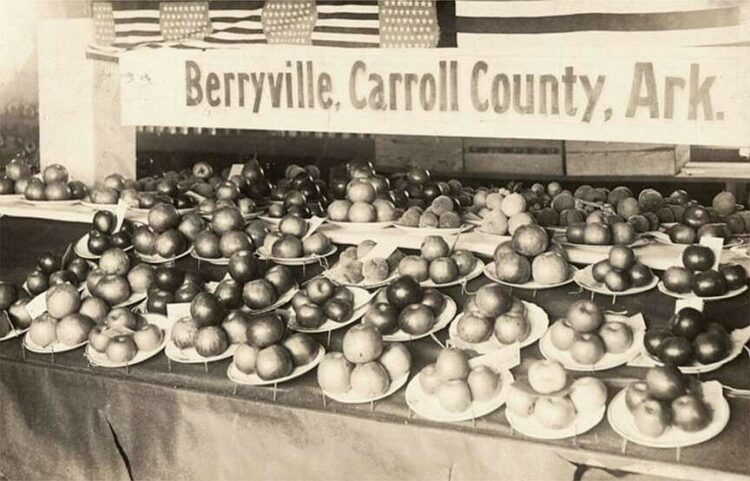Seventy-five years after their introduction in Arkansas, apples became a dominant agricultural crop and an economic engine for the northwestern part of the state. However, their importance declined measurably in the last half of the 20th century.
The apple of commerce, Malus domestica, is not native to North America. It is a complex hybrid of Malus species with origins in Asia and Europe. Malus domestica was introduced to North America by 16th-century explorers and later by colonists. Settlers arriving in Arkansas from Tennessee, the Carolinas and Georgia brought apple seeds and scion wood with them. The Arkansas Gazette reported in 1822 that apples were being grown on the farm of James Sevier Conway west of Little Rock.
While apples are grown throughout the state, the Ozark Plateau region of Northwest Arkansas was particularly suited for their culture. This area became the dominant region for apple production.
The influx of settlers into the Washington County area of Northwest Arkansas led to the spread of apples. Most homesteads had kitchen orchards for family use. Nurseries were established at Cane Hill in 1835 and at Bentonville in 1836 to meet the need for apple trees. Excess production from expansion of kitchen orchards was sold to freighters who hauled apples to distant markets in open wagons. In 1852, a wagon train to Van Buren delivered apples to be sent by boat to Little Rock.
What is considered the first commercial apple orchard in the state was planted by a Cherokee woman near Maysville prior to the Civil War and maintained through the use of slave labor. Other commercial orchards were planted in the 1870s; by 1880, apple production exceeded what freighters could haul. The expanding “Apple Belt of the Ozarks” had become a production area isolated from markets because it was devoid of sufficient transportation access.
The entry of railroad lines into the state offered access to distant markets as far as Maine and Saskatchewan, Canada. These new market outlets ultimately resulted in a massive increase in commercial orchard plantings in northwestern Arkansas from 1880 to 1920. By 1900, the acreage devoted to apples amounted to approximately 40,000 acres in Benton County, with only slightly smaller acreage in Washington County. Along with the great orchard expansion, supporting industries developed: barrel making, apple drying, distilling juice, packing sheds, and ice-making plants.
What is now the University of Arkansas established experiments in scientific horticulture, thus becoming an important asset to the apple industry. Its first bulletin in 1886 dealt with apples. The Arkansas State Horticultural Society, catering primarily to apple growers since 1900, held annual meetings in various locations in the area for discussion and dissemination of knowledge in orchard culture. Seedling varieties selected by growers and nurserymen played a significant role in production. More than 50 were named but had only local name recognition; among them were the Shannon Pippin, Ada Red, Red Streak, Etris, Gano and Coffelt. The Arkansaw (or Mammoth Black Twig) and the Arkansas Black were the most well known.
From a crop of some 3 million bushels in 1906 to record production of more than 5 million bushels in 1919, production declined steadily to less than 2 million bushels in 1935 to crops of less than 250,000 bushels by the 1960s. Among the numerous reasons for the decline were poor varieties, namely the Ben Davis, but also the consequences of an expanding monoculture resulting in increases in insect and disease pressure. Diseases such as fire blight (a bacterial disease native to North America and particularly destructive to apple trees) and Cedar Apple and Apple Scab fungal diseases — common in Arkansas orchards after the 1880s — coupled with insects such as the codling moth, introduced from England, and the San Jose scale, introduced from China, seriously hampered apple growing.
By resolution of the Arkansas General Assembly in 1901, the apple blossom was declared the state flower. An exhibit of Arkansas apples won first prize at the Centennial Fair in Philadelphia in 1876. In 1900, the Arkansas Black variety won first prize at an exhibition in Paris. Arkansas apples exhibited at the St. Louis World’s Fair in 1905 won in all major categories. According to the Arkansas Sentinel, a fair in Springdale saw more than 140 seedling entries, and the top award went to the Mammoth Black Twig. The prize was $10.
The first Apple Blossom Festival was held in Rogers in 1923 and featured a parade with floats from schools, clubs, civic organizations and businesses. The 1926 festival drew over 30,000 people. From 1932 to 1942, the South West Times Record of Fort Smith sponsored apple blossom pilgrimages. The paper distributed road maps to orchard locations. The town of Lincoln revived the festival feature and has had a fall Arkansas Apple Festival every year since 1976. — Roy Curt Rom
This story is adapted by Guy Lancaster from the online Encyclopedia of Arkansas, a project of the Central Arkansas Library System. Visit the site at encyclopediaofarkansas.net.
Source link : http://www.bing.com/news/apiclick.aspx?ref=FexRss&aid=&tid=67441513668743ffad4eb7517bb1407f&url=https%3A%2F%2Fwww.nwaonline.com%2Fnews%2F2024%2Fnov%2F23%2Farkansas-a-z-apple-industry-rose-fell-in%2F&c=9983013204824006041&mkt=en-us
Author :
Publish date : 2024-11-23 00:00:00
Copyright for syndicated content belongs to the linked Source.
